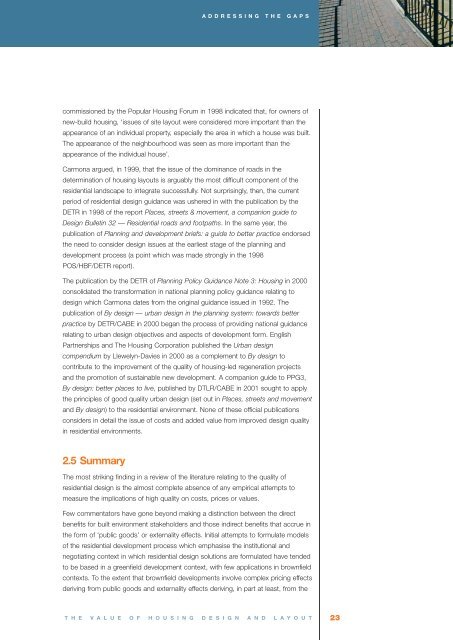The value of housing design and layout
The value of housing design and layout
The value of housing design and layout
You also want an ePaper? Increase the reach of your titles
YUMPU automatically turns print PDFs into web optimized ePapers that Google loves.
commissioned by the Popular Housing Forum in 1998 indicated that, for owners <strong>of</strong><br />
new-build <strong>housing</strong>, ‘issues <strong>of</strong> site <strong>layout</strong> were considered more important than the<br />
appearance <strong>of</strong> an individual property, especially the area in which a house was built.<br />
<strong>The</strong> appearance <strong>of</strong> the neighbourhood was seen as more important than the<br />
appearance <strong>of</strong> the individual house’.<br />
Carmona argued, in 1999, that the issue <strong>of</strong> the dominance <strong>of</strong> roads in the<br />
determination <strong>of</strong> <strong>housing</strong> <strong>layout</strong>s is arguably the most difficult component <strong>of</strong> the<br />
residential l<strong>and</strong>scape to integrate successfully. Not surprisingly, then, the current<br />
period <strong>of</strong> residential <strong>design</strong> guidance was ushered in with the publication by the<br />
DETR in 1998 <strong>of</strong> the report Places, streets & movement, a companion guide to<br />
Design Bulletin 32 — Residential roads <strong>and</strong> footpaths. In the same year, the<br />
publication <strong>of</strong> Planning <strong>and</strong> development briefs: a guide to better practice endorsed<br />
the need to consider <strong>design</strong> issues at the earliest stage <strong>of</strong> the planning <strong>and</strong><br />
development process (a point which was made strongly in the 1998<br />
POS/HBF/DETR report).<br />
<strong>The</strong> publication by the DETR <strong>of</strong> Planning Policy Guidance Note 3: Housing in 2000<br />
consolidated the transformation in national planning policy guidance relating to<br />
<strong>design</strong> which Carmona dates from the original guidance issued in 1992. <strong>The</strong><br />
publication <strong>of</strong> By <strong>design</strong> — urban <strong>design</strong> in the planning system: towards better<br />
practice by DETR/CABE in 2000 began the process <strong>of</strong> providing national guidance<br />
relating to urban <strong>design</strong> objectives <strong>and</strong> aspects <strong>of</strong> development form. English<br />
Partnerships <strong>and</strong> <strong>The</strong> Housing Corporation published the Urban <strong>design</strong><br />
compendium by Llewelyn-Davies in 2000 as a complement to By <strong>design</strong> to<br />
contribute to the improvement <strong>of</strong> the quality <strong>of</strong> <strong>housing</strong>-led regeneration projects<br />
<strong>and</strong> the promotion <strong>of</strong> sustainable new development. A companion guide to PPG3,<br />
By <strong>design</strong>: better places to live, published by DTLR/CABE in 2001 sought to apply<br />
the principles <strong>of</strong> good quality urban <strong>design</strong> (set out in Places, streets <strong>and</strong> movement<br />
<strong>and</strong> By <strong>design</strong>) to the residential environment. None <strong>of</strong> these <strong>of</strong>ficial publications<br />
considers in detail the issue <strong>of</strong> costs <strong>and</strong> added <strong>value</strong> from improved <strong>design</strong> quality<br />
in residential environments.<br />
2.5 Summary<br />
ADDRESSING THE GAPS<br />
<strong>The</strong> most striking finding in a review <strong>of</strong> the literature relating to the quality <strong>of</strong><br />
residential <strong>design</strong> is the almost complete absence <strong>of</strong> any empirical attempts to<br />
measure the implications <strong>of</strong> high quality on costs, prices or <strong>value</strong>s.<br />
Few commentators have gone beyond making a distinction between the direct<br />
benefits for built environment stakeholders <strong>and</strong> those indirect benefits that accrue in<br />
the form <strong>of</strong> ‘public goods’ or externality effects. Initial attempts to formulate models<br />
<strong>of</strong> the residential development process which emphasise the institutional <strong>and</strong><br />
negotiating context in which residential <strong>design</strong> solutions are formulated have tended<br />
to be based in a greenfield development context, with few applications in brownfield<br />
contexts. To the extent that brownfield developments involve complex pricing effects<br />
deriving from public goods <strong>and</strong> externality effects deriving, in part at least, from the<br />
T H E V A L U E O F H O U S I N G D E S I G N A N D L A Y O U T<br />
23

















